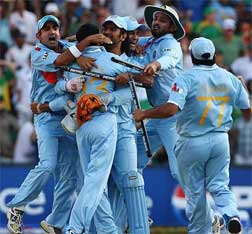Basic Rules
Cricket is played by two teams of eleven on a level, closely cut oval “pitch” preferably measuring about 525 ft (160 m) by about 550 ft (170 m). Two wickets are placed 66 ft (20.12 m) apart near the middle of the field. A wicket consists of two wooden crosspieces (bails) resting on three wooden stumps 28 in. (71.1 cm) high.
At each wicket stands a batsman. If the opposing bowler, delivering the ball from near the opposing wicket, knocks down the bails of the batsman's wicket, the batsman is retired. In delivering the hard, leather-covered ball, the bowler throws overarm but may not bend the arm, and the ball usually approaches the batsman on one bounce. After six bowls to one batsman, an umpire (there is one at each wicket) calls “over,” and another bowler begins bowling to the batsman's partner at the opposing wicket. The players in the field shift position according to the batsmen.
If the batsman hits the ball with his willow paddle-shaped bat far enough so that both batsmen may run to exchange places, a run is scored. When the ball is hit a long distance (in any direction, since there are no foul lines), up to four exchanges or runs may be made. (If the ball crosses the boundary of the field on the ground, four runs are scored automatically; if it clears the boundary in the air, six are scored.) However, if the opposing team recovers the ball and uses it to knock down the bails of a wicket before the batsman reaches it, the batsman is out. A batsman is also retired if an opposing fielder catches a batted ball on the fly (as in baseball), or for any of several more technical reasons. An outstanding turn at bat may result in more than 100 runs, a “century.”
A game usually consists of two innings; in one innings all players on each team bat once in a fixed order (unless a team, having scored what it considers runs adequate to win, chooses to retire without completing its order); a game may take several days to complete. Substitutions are allowed only for serious injury.
Origin of Cricket
Cricket's origin is obscure. Evidence suggests it was played in England in the 12th–13th cent., and it was popular there by the end of the 17th cent. By the mid-18th cent. the aristocracy had adopted the game. In 1744 the London Cricket Club produced what are recognizably the rules of modern cricket. The Marylebone Cricket Club, one of the oldest (1787) cricket organizations, is the game's international governing body.
Principal Modern Matches
In Great Britain the principal cricket matches are those between the universities (especially Oxford and Cambridge) and between largely professional teams representing the English counties. Among international, or test, matches (begun 1877), the most famous is that between Australia and Britain for the “Ashes.” Since the 1970s the West Indies (a team assembled from several nations), India, Pakistan, and South Africa have challenged English and Australian claims to world dominance.




